| As of mid-2011
the series comprises the following kits.
- 7234 Sd.Kfz.164 Hornisse
(see here)
- 7235 StuG IV Early
(see here and here)
- 7238 Jagdpanzer IV L/70
Command
- 7242 Brummbär mid production
(see here)
- 7244 Sd.kfz.165 Hummel Early
Version (see here)
- 7260 StuG IV Late
(see here, here
and here)
- 7276 Jagdpanzer IV L/48
- 7278 Pz.Kpfw.IV Ausf. G
- 7292 Sd.Kfz.164 Nashorn
(see here)
- 7293 Jagdpanzer IV L/70
Late Production (see here
and here)
- 7301 Sd.kfz.165 Hummel late version
- 7307 Jagdpanzer IV L/70
Early Production
- 7321 Pz.Kpfw.IV Ausf. F1 (F) (see
here)
- 7359 Pz.Kpfw.IV Ausf. F2
While some of these kits were already
the subject of a specific review, as mentioned above, we will only
outline the differences between the different kits in this article.
Overview
| |
7244
Hummel Early
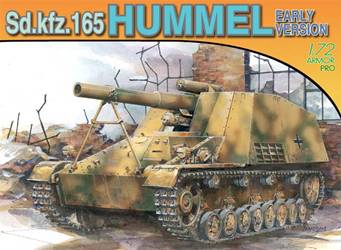
|
7234
Hornisse
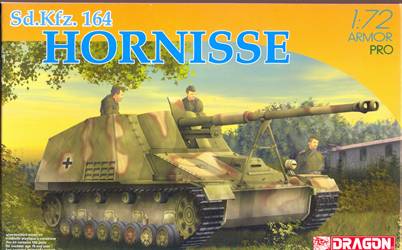 |
7292
Nashorn
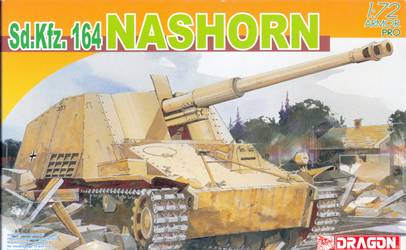 |
7276
Jagdpanzer IV L/48
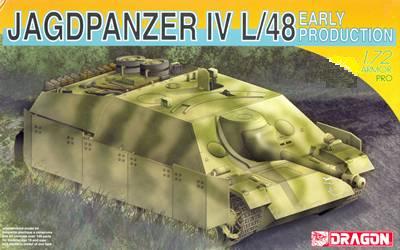
|
7307
Jagdpanzer IV L/70 Early
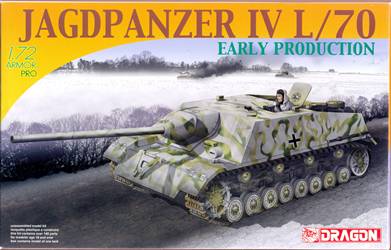
|
7293
Jagdpanzer IV L/70 Late
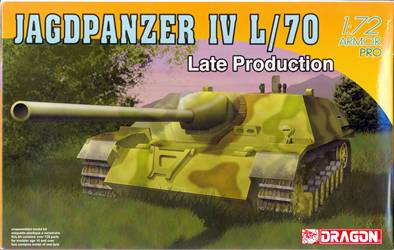
|
7238
Jagdpanzer IV L/70
Befehl
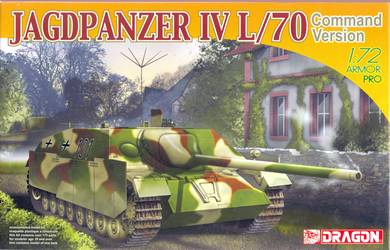
|
7235
StuG IV Early
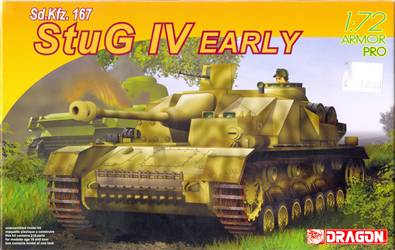
|
7260
StuG IV Late
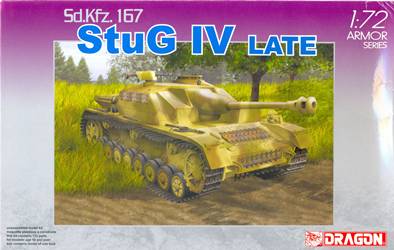
|
Tracks |
|
|
Roadwheels & Hubcaps
|
|
2
x Sprue "K" (Universal type)
Late hubcaps |
2
x Sprue "K" (Universal type)
Late hubcaps |
2
x Sprue "K" (Universal type)
Late hubcaps
1 x Sprue "P" (Steelwheels) |
2
x Sprue "K" (Universal type)
Late hubcaps
1 x Sprue "P" (Steelwheels) |
2
x Sprue "K" (Universal type)
Late hubcaps |
2
x Sprue "K" (Universal type)
Late hubcaps |
Return Rollers
|
"M"
Rubber return rollers |
"f"
Rubber return rollers
(Same as "M") |
"F"
Steel return rollers |
"M"
Rubber return rollers |
Steel
return rollers (different from "F") |
Steel
return rollers (different from "F") |
"F"
Steel return rollers |
"F"
Steel return rollers |
| Drive Sprocket |
Late
sprocket
Alternative
late sprocket without cover for the bolts (but not marked
on the manual) |
|
|
Idler
|
|
Tubular
idler, Sprue "J" |
Tubular
idler, Sprue "J" |
Tubular
idler, Sprue "J" |
Tubular
idler, Sprue "J" |
Idler
with angular spokes, Sprue "G" |
Tubular
idler, Sprue "J" |
| Suspension |
|
|
Lower Hull |
L |
I |
Four
return roller type,
holes for screws |
Four
return roller type,
no holes for screws |
Three
return roller type,
holes for screws |
Three
return roller type,
no holes for screws |
"E",
StuG hull,
four return rollers |
"L",
StuG hull,
four return rollers |
| Hull |
A
B
Part
of C |
A
B
C |
Sprue
"A"
(See comments below)
|
Sprue
"A" |
|
| Sprue
B |
Sprue
C
Barrel w/o notch |
Sprue
C
Barrel with notch |
Sprue
C
Barrel w/o notch |
|
| Other Sprues |
Parts
of D
E
G |
D
Parts
of E
F
(with specific parts blanked off) |
F
(with specific parts blanked off) |
|
Early
Sprue "B" |
Late
Sprue "B" |
| Early
Sprue "D" |
Late
Sprue "D" |
| Schürzen,
Sprue "E" |
Isolated
parts of L/48 kit |
|
Schürzen,
Sprue "E" |
Schürzen,
Sprue "N" |
|
| Metal |
Holders
for spare wheels |
|
Holders
for spare wheels |
|
Gun
Barrel |
Gun
Barrel |
Rod for antenna (not included
in my kit, or already lost) |
|
| PE |
|
Schürzen |
Small
parts |
|
Small
parts, incl. Sternantenna |
Schürzen |
|
Note that sprue D from the Hornisse
is not included in the early Hummel. This is a pity as it contains
the early exhaust seen on very early Hummels.
Also note that the tracks in the Hornisse/Nashorn/Hummel kits seem
to be the same as in the other kits, while the original vehicles had
a slightly longer chassis.
Manual and remarks
7244 Sd.Kfz.165 Hummel Early
version
7234 Sd.Kfz.164 Hornisse
7292 Sd.Kfz.165 Nashorn






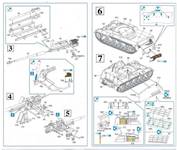
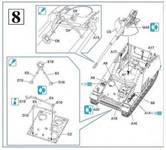
Scans above by Henk
of Holland, used with permission
  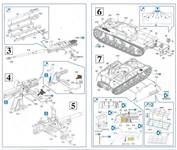 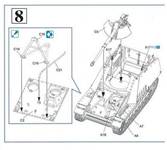
Scans above by Henk
of Holland, used with permission
These three kits are very similar if
one makes abstraction of the use of different guns.
Small differences exist between the Hornisse and the Nashorn, like
the gun barrel, travel locks, exhaust arrangement and the absence
of spare road wheels in the Hornisse (which is basically an early
Nashorn).
It seems that the Hornisse has all the parts for the Nashorn, so you
could build either one using the former kit using the instructions
above.
There is an extra front visor on sprue A "not for use" in
all kits. According to the scans of the instructions I have seen this
is meant for the late Hummel (with wider driver's compartment).
Of note is the presence of a part number E20 on the sprues of the
Hummel, but the part itself is blanked off. According to the scans
of the instructions I have seen this is the driver's roof for the
late Hummel.
It also of note that extremely small bits of sprues are inluded in
some of the kits. To me it looks like complete sprues were cast, these
bits cut off, and the remainder thrown away.
7235 StuG IV Early
7260 StuG IV Late
  
  
These kits have a lot in common, but
are still sufficiently different.
One of the main differences can be found in the lower hull. The "late"
has three return rollers while the "early" has four. Other
differences in the hull are the two holes in the bottom for display
screws on the "early", and the extended hull sides for tow
hooks on the "late". Why they are actually there puzzles
me, as you need to saw them off according to the instructions. I should
check my references to know if none of the late StuGs ever had these.
While the manual of the "early" still has you assemble 18
road-wheels, like that of the "late", the box with the two
spare road-wheels that goes on the side of the fighting compartment
actually comes as a separate part for that kit, i.e. with the roadwheels
integrally molded with the box. I see no reason why Dragon changed
their tactic.
Another odd difference can be found in the presence of Schürzen
for the "early" kit, while none is to be had with the "late".
I am quite sure late StuGs also carried them. The "early"
kit even has them twice: once in plastic, once in PE. Using the spares
for the "late" is no direct solution, as you still would
need to find mounting rails somewhere in your spare's box.
(The presence of PE parts in the "early" kit probably explains
why this is an "Armor Pro" series, while the other is not.)
While, at first, I thought the manuals
showed actual kits under construction, I have come to believe that
these are probably CAD designs, which are clear enough to me, even
if you need to get used to them a bit.
An error in the "early" kit's manual can be found in the
way the MG is mounted on the roof. The shield cannot possible be in
the upright position without the loader's hatch supporting it, i.e.
it always laid flat when those hatches were closed. While you have
parts for a closed and for an open hatch, Dragon does not mention
that you can actually leave those hatches open. The same remark holds
for the commander's and driver's hatch. I will need to dig deeper
in my references when I build these kits, but I thought there was
a difference between the driver's hatches on the early and late StuG
IVs, while Dragon does not seem to make any distinction.
Something else that struck me as odd,
is that Dragon gives you a Sprue "D" that is specific for
the early StuG, but with two parts on it that are not for use.
7276 Jagdpanzer IV L/48 "Early
production"
7307 Jagdpanzer IV L/70 "Early production"
7293 Jagdpanzer IV L/70 "Late production"
7238 Jagdpanzer IV L/70 "Command version"
  

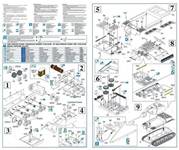
 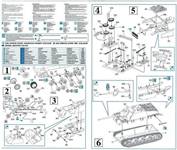
  
Scans for 7307 & 7293 by Henk
of Holland, used with permission
Construction of these four kits is
pretty similar. Some have PE parts to replace smaller plastic bits,
while others only offer the plastic bits. I've always found this to
be an erratic strategy that Dragon seems to follow.
In the same line of erratic behavior lies the fact that we get nice
metal gun barrels for the Jagdpanzer L/70 "Early" and "Late",
but not for the Command Version, while it had exactly the same gun.
Talking about the gun, some of the kits have the corresponding plastic
part molded with a step (notch) at the base, while some haven't. For
some reason, Dragon changed the molds.
Note that the early Jagdpanzer comes with two types of gun: with and
without muzzle brake.
Furthermore, while I believe all Jagdpanzer IVs would have carried
Schürzen, only the L/48 and Command version can be built with
them. The L/48 even has them twice (PE and plastic). As all kits have
the mounting brackets included (and the L/70 "Late" kit
would even have you install them), you can at least cover another
kit with these skirts.
The sprue for the engine deck is another
aberration, as part 3 (a complete engine deck with closed hatches
and integrally molded tools) is not for use in any kit. That's not
a big deal, as you also get an engine deck with open hatches and separate
tools, but I don't see why it would need to be included. Neither did
Dragon, it seems, as at some point they blanked off the sprue gate
for this part, but in a very non-systematic way:
- not included in the Japgdanzer IV L/48 kit
- included, but marked not for use in the Jagdpanzer L/70 "Early"
kit
- not included, but marked as included/not for use in the Jagdpanzer
L/70 Late kit. (The manual is thus incorrect.)
- included, but marked as not for use in the Jagdpanzer L/70 Befehl
Sprue E, the one with the Schürzen,
also contains hooded vertical exhausts (i.e. the very late type) which
are "not for use" in any kit. Nice for the spare's box,
or for use on the Jagdpanzer IV L/70 "Late" kit.
The manual differs from that of the
StuG kits in that it is now of the "line drawing" type.
A note about Zimmeritt.
- The Jagdpanzer IV L/48 "Early
production": according to my info, most of these L/48
armed vehicles had Zimmerit, which the kit doesn't have. Possible
exceptions are the very late ones that had no muzzle break for the
L/48 gun. So, either you add Zimmerit, or you go for a late early
Jagdpanther.
- The Jagdpanzer IV L/70 "Early
production": according to my info most of these early
L/70 armed vehicles, i.e. the ones with four return rollers and
no steel roadwheels, had Zimmerit, which the kit doesn't have.
The L/48
kit has four steel return rollers, while the early L/70 kit has four
rubber return rollers. I always thought the L/70 came after the L/48
and the rubber wheels before the steel wheels, so this is suspicious,
although I can't tell for sure (yet) if this is correct.
The Jagdpanzer IV L/70 kits 7293 and 7238 come with 9 steel roadwheels,
while you only need 4 (plus perphaps two spares).
Also
note that the upper hull (including the engine deck) is 0.5 to 1.0
mm too high. This shows in the position of the gun mantlet and the
size of the small rear additional armor plates.
A more
detailed discussion about the chronological features of kit 7276 (the
L/48 kit) can be found here.
Bruce
Probst adds the following:
In
2005 (I believe) Dragon released kit 7293 "Jagdpanzer IV L/70
Late Production" which included an aluminium gun barrel.
In 2020 the kit has been re-issued, with the same kit number but
different
box art and different contents: there is no longer an aluminium
barrel but a slide-moulded plastic one instead (which in the kit
I purchased seems slightly warped). I believe the original release
of the kit also included the plastic barrel (Ed. Note: it did),
although my kit also included a large number of alternative wheel
hubs (I think?) (in plastic) which are not mentioned anywhere in
the instructions (Ed. note: these were already included in the
original release).
Unfortunately many retailers seem to have not noticed these changes
and still market the more recent kit as if it were the original
release, now making it a case of "buyer be alert!".
Although Scalemates claims this kit is number "7293P"
that doesn't appear anywhere on the box -- it's just 7293.
Decals and
Markings
Decals are by Cartograf
and look very good on the sheet.
7244 Sd.Kfz.165 Hummel Early
version
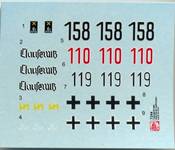


5 color markings.
- Unidentified Unit, Eastern Front,
1944, 3-tone camo
- "Das Reich" Division,
Normandy, 1944, 3-tone camo, number 119
- Unidentified Unit, Eastern Front,
1944, mostly white, but 3-tone camo on barrel and dark yellow fighting
compartment
- "Das Reich" Division,
Normandy, 1944, 3-tone camo, number 110 "Clausewitz"
- 5 Pz.Div., Russia, 1944, 3-tone
camo, number 1585
7234 Sd.Kfz.164 Hornisse
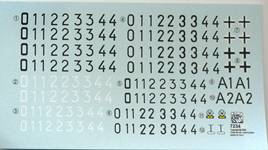
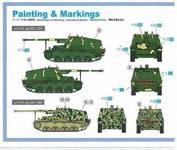
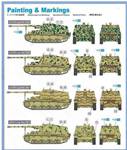
Scans of manual by Henk
of Holland, used with permission
6 color markings and lots of spare
numbers in various styles.
- s.H.Pz.Jg.Abt. 525, 3-tone camo,
mainly green
- s.H.Pz.Jg.Abt. 560, number A2, green
over dark yellow
- s.H.Pz.Jg.Abt. 525, number 131,
green over dark yellow
- s.H.Pz.Jg.Abt. 525, number 211,
3-tone camo
- s.H.Pz.Jg.Abt. 560, number 233,
brown over dark yellow
- s.H.Pz.Jg.Abt. 525, number 302,
green over dark yellow
7292 Nashorn

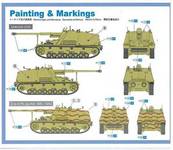 
Scans of manual by Henk
of Holland, used with permission
7 color markings and lots of spare
numbers in various styles.
- Unknown unit, overall dark yellow
- s.H.Pz.Jg.Abt. 560, 1943, number
231, brown wavy pattern over dark yellow
- s.H.Pz.Jg.Abt. 519, 1943-44, "Tiger",
white over dark yellow
- s.H.Pz.Jg.Abt. 88, 1944, white squiggles
over dark yellow
- s.H.Pz.Jg.Abt. 525, 1944, number
131, 3-tone camo
- s.H.Pz.Jg.Abt. 525, 1944, number
214, 3-tone camo
- s.H.Pz.Jg.Abt. 88, 1944, red heart,
green over dark yellow
7276 Jagdpanzer IV L/48 "Early
production"
 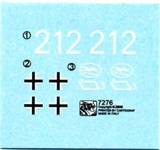
Little in the way of markings, but
four color schemes nevertheless:
- Pz.Jg.Abt.228, 116 Pz.Div., Normandy,
1944
- Pz.Jg.Abt.12, 12 Pz.Div., Normandy,
1944. As far as I know, 12 Pz.Div. was fighting for survival in
the Baltic area during 1944. I can only assume that, once again,
this is Dragon's PC way to indicate 12 SS Pz.Div. "HJ".
- Unidentified unit, Germany 1945
- Pz.Gren.Div. "Hermann Göring",
East Prussia, 1945
7307 Jagdpanzer IV L/70 "Early
production"
 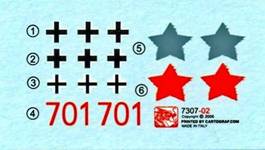
Four marking options are offered:
- Unidentified unit, Germany, 1945
- 9 Pz.Div., Hungary, 1945
- Pz.Div. "Feldhernhalle",
Budapest 1945
- Unidentified unit, Eastern Front,
1945
The last option carries crude stars, either
dark grey/green or red, and represents, according to my sources, a vehicle
used by the Bulgarians after they switched sides.
7293 Jagdpanzer IV L/70 "Late
production"
 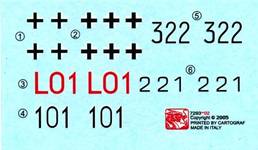
Five marking options, four of which
belong to the crack "unidentified unit":
- "L01". Unidentified unit,
Hungary, 1945. Timothy Lau points out that, if this vehicle existed,
it was probably a command vehicle.
- Unidentified unit, Germany, 1945
- "322",
s.Pz.Abt.665, Germany, 1945
- "101",
Unidentified unit, Germany, 1945. Timothy Lau points out that this
is the probably a command vehicle.
- "221", Unidentified unit,
Germany, 1945. Timothy Lau points out that this
vehicle is probably what the markings are based on.
Strangely enough, the third, resp. fourth and fifth, option depicts
a vehicle from the same unit AND with the same number as the
third, resp. first and second, one in kit 7238. They even have the
same camouflage pattern, but lack Schürzen in this kit.
7238 Jagdpanzer IV L/70 "Command
version"
 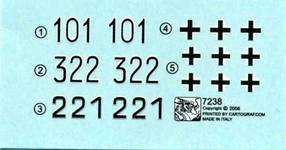
Five marking options, four of which belong to the crack "unidentified
unit":
- "101", Unidentified unit,
Germany, 1945. Timothy Lau points out that this
is the probably the command vehicle in question.
- "221", Unidentified unit,
Germany, 1945. Timothy Lau points out that this
vehicle does not look like a command vehicle.
- "322", s.Pz.Abt.665,
Germany, 1945
- Unidentified unit, Hungary, 1945
- Unidentified unit, Hungary, 1945
Strangely enough, the first, resp.
second and third, option depicts a vehicle from the same unit AND
with the same number as the fourth, resp. fifth and third, one in
kit 7293. They even have the same camouflage pattern, but have Schürzen
in this kit.
7235 StuG IV Early

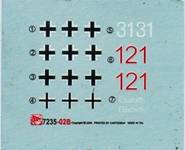
Seven marking options are provided:
- 24 Inf.Div., Germany 1945
- Unknown unit, Gothic Line, Italy,
1944
- Unknown unit, Eastern Front, Poland,
1944
- 1 Pz.Div., Hungary, 1945
- Unknown unit, Lake Balaton area,
Hungary, 1945
- "Elsabeth", 912 StuG Brigade,
Kurland, 1945. Timothy Lau points out that this
vehicle had both features of an early and of a late StuG IV.
- Unknown unit, Germany, 1945
I didn't see any difference in the
Balkenkreuze marked with (1) and (2), but I am sure there must be
a reason to distinguish between them.
7260 StuG IV Late
 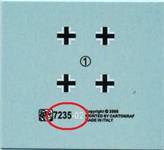
In my opinion this kit is a rip-off
when it comes to markings. All you get is two marking options ("Yugoslavia,
Spring 1945" and "Unknown Unit, Germany, 1945") and
only four Balkenkreuze. OK, you only need three, so you have something
to add to your spare's box, but I've become used to a wider choice.
Remarkably, the sheet is marked as "7235", which would imply
that it was originally meant for the "early" StuG. |